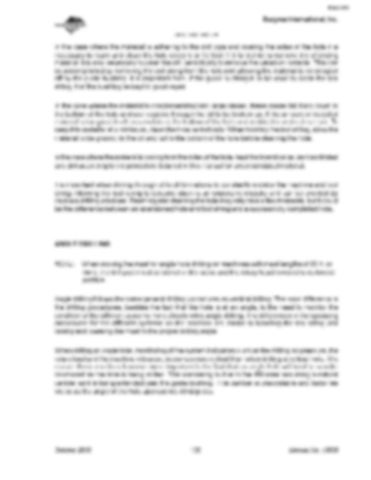BI619852
Bucyrus International, Inc. 59HR Blast Hole Drill
In the case where the material is adhering to the drill pipe and coating the sides of the hole it is necessary to ream and clean the hole every 5 to 10 feet (1.5 to 3.0 m) to remove the offending material. It is also necessary to clean the drill periodically to remove the caked on material. This can be accomplished by removing the tool string from the hole and allowing the material to be scraped off by the guide bushing. It is important then, if the guide bushing is to be used to clean the tool string, that the bushing be kept in good repair. In the case where the material is conglomerating into large pieces, these pieces fall back down to the bottom of the hole and are recycled through the bit to be broken up. If the amount of recycled material is too great it will accumulate at the bottom of the hole and restrict the main air stream. To keep this material at a minimum, clean the hole periodically. When hoisting the tool string, allow the material to be ground by the bit and fall to the bottom of the hole before cleaning the hole. In the case where the material is caving from the sides of the hole, treat the formation as unconsolidated and drill according to the procedure detailed in this manual for unconsolidated material. It is important when drilling through difficult formations to constantly monitor the machine and tool string. Allowing the tool string to become stuck is an expensive mistake and can be avoided by cautious drilling practices. Reaming and cleaning the hole may only take a few moments, but it could be the difference between an abandoned hole and tool string and a successfully completed hole.
ANGLE DRILLING NOTE:
When moving the mast for angle hole drilling on machines with mast lengths of 65 ft. or more, the drill pipe must be stored in the racks and the rotary head lowered to its lowest position.
Angle drilling follows the same general drilling procedures as vertical drilling. The main difference in the drilling procedures, besides the fact that the hole is at an angle, is the need to monitor the condition of the different systems more closely while angle drilling. The differences in the operating procedures for the different systems on the machine are limited to handling the tool string and raising and lowering the mast to the proper drilling angle. When drilling an angle hole, monitoring of the system indicators such as the drilling air pressure, the rotary load and the machine vibration, becomes more critical than when drilling a vertical hole. The reason these monitors become more important is the fact that an angle hole will tend to wander downward as the hole is being drilled. This wandering is due to the drill steel assuming a natural camber as it is being extended past the guide bushing. This camber is unavoidable and becomes worse as the angle of the hole approaches 30 degrees.
October 2009
109
Manual No. 10836


